Report: Different Business Types, Structures, and PESTLE Analysis
VerifiedAdded on 2023/01/06
|10
|2487
|40
Report
AI Summary
This report provides a comprehensive overview of different business types, including micro, small, medium, and large enterprises, and various business structures like sole traders, partnerships, and limited liability companies. It explores the impact of different organizational structures, such as functional and divisional structures, on productivity and profitability. The report also conducts a PESTLE analysis to examine the influence of political, economic, social, technological, legal, and environmental factors on business performance. The analysis considers how these external factors affect business operations and strategies, offering insights into market dynamics and decision-making processes. The report concludes by summarizing the key findings and emphasizing the importance of understanding both internal structures and external environments for business success.
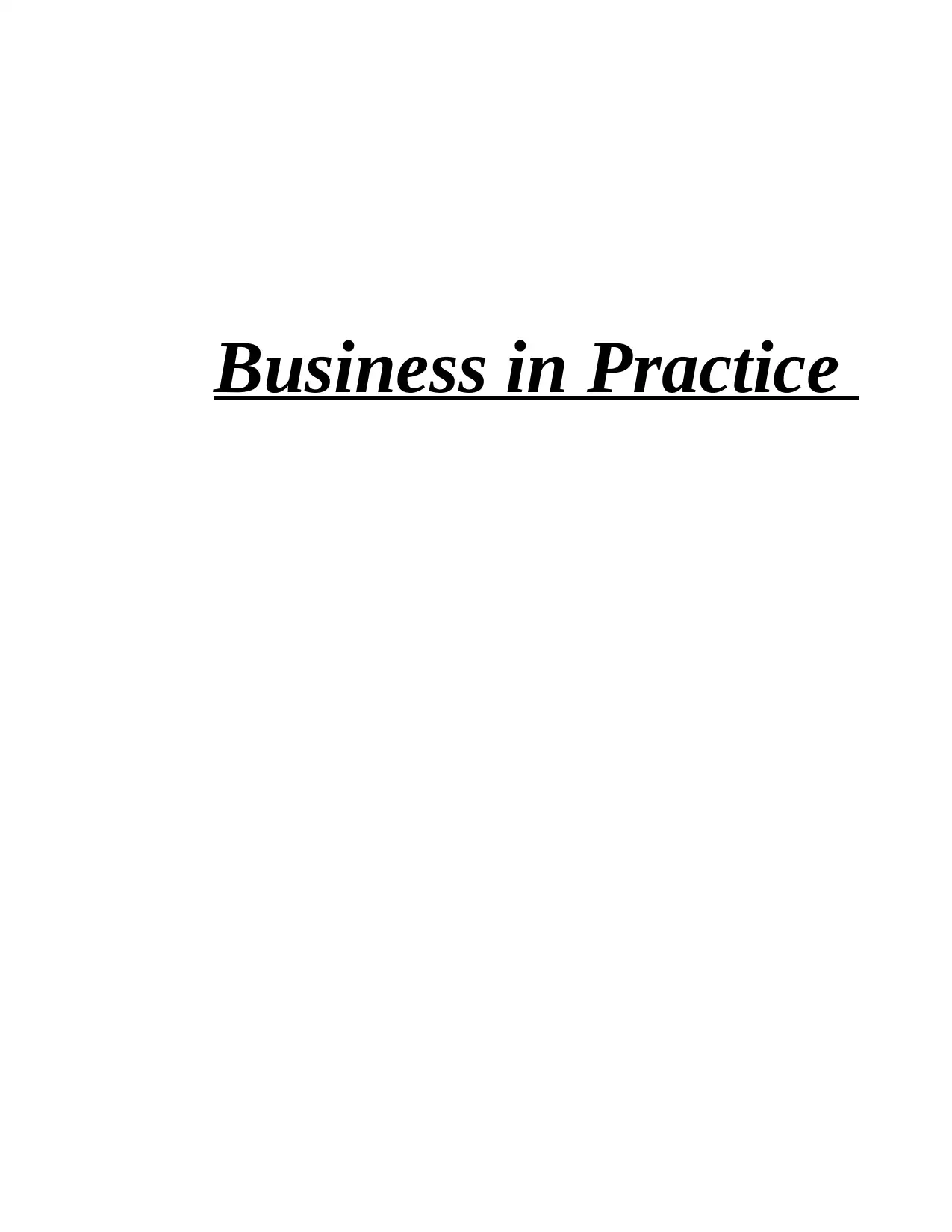
Business in Practice
Paraphrase This Document
Need a fresh take? Get an instant paraphrase of this document with our AI Paraphraser
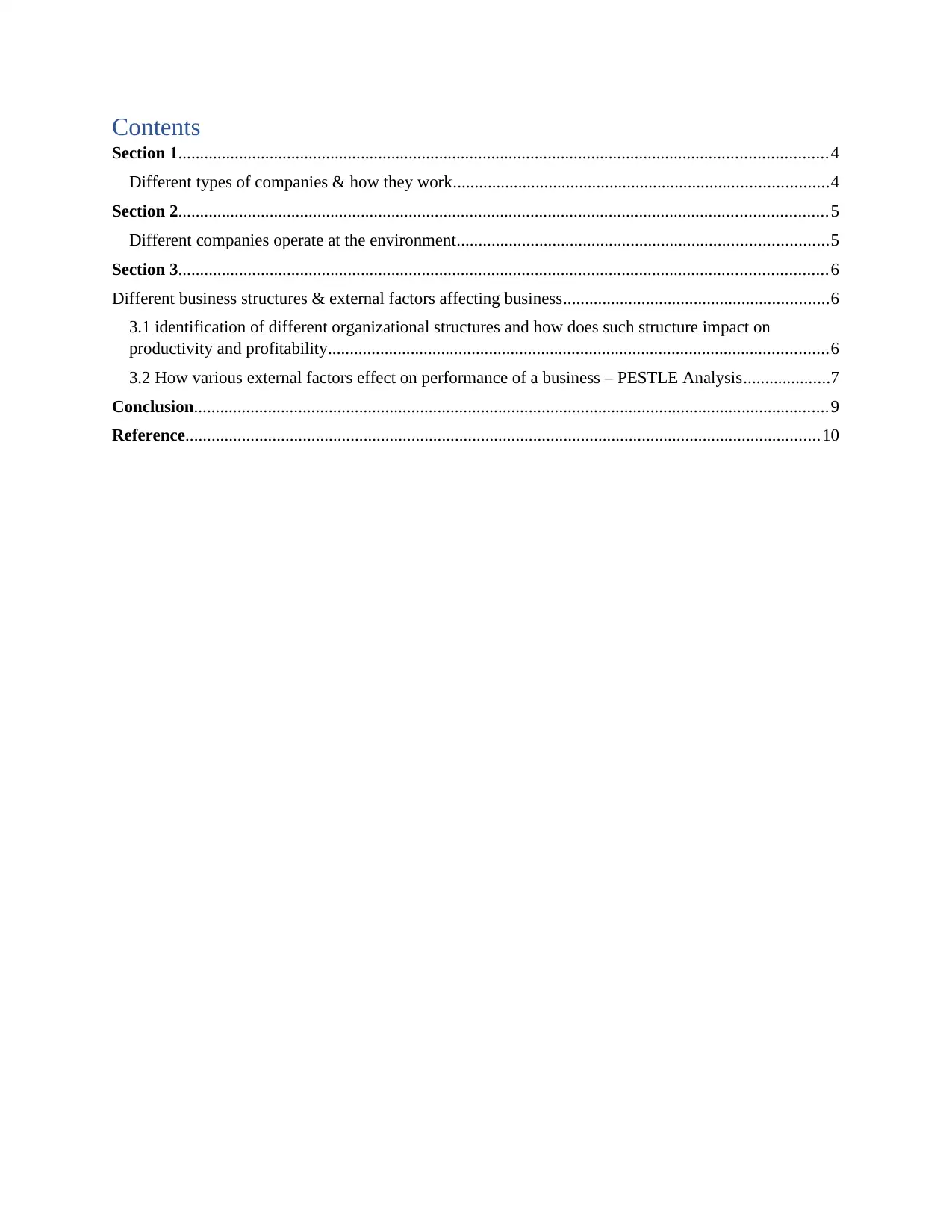
Contents
Section 1.....................................................................................................................................................4
Different types of companies & how they work......................................................................................4
Section 2.....................................................................................................................................................5
Different companies operate at the environment.....................................................................................5
Section 3.....................................................................................................................................................6
Different business structures & external factors affecting business.............................................................6
3.1 identification of different organizational structures and how does such structure impact on
productivity and profitability...................................................................................................................6
3.2 How various external factors effect on performance of a business – PESTLE Analysis....................7
Conclusion..................................................................................................................................................9
Reference..................................................................................................................................................10
Section 1.....................................................................................................................................................4
Different types of companies & how they work......................................................................................4
Section 2.....................................................................................................................................................5
Different companies operate at the environment.....................................................................................5
Section 3.....................................................................................................................................................6
Different business structures & external factors affecting business.............................................................6
3.1 identification of different organizational structures and how does such structure impact on
productivity and profitability...................................................................................................................6
3.2 How various external factors effect on performance of a business – PESTLE Analysis....................7
Conclusion..................................................................................................................................................9
Reference..................................................................................................................................................10

⊘ This is a preview!⊘
Do you want full access?
Subscribe today to unlock all pages.

Trusted by 1+ million students worldwide
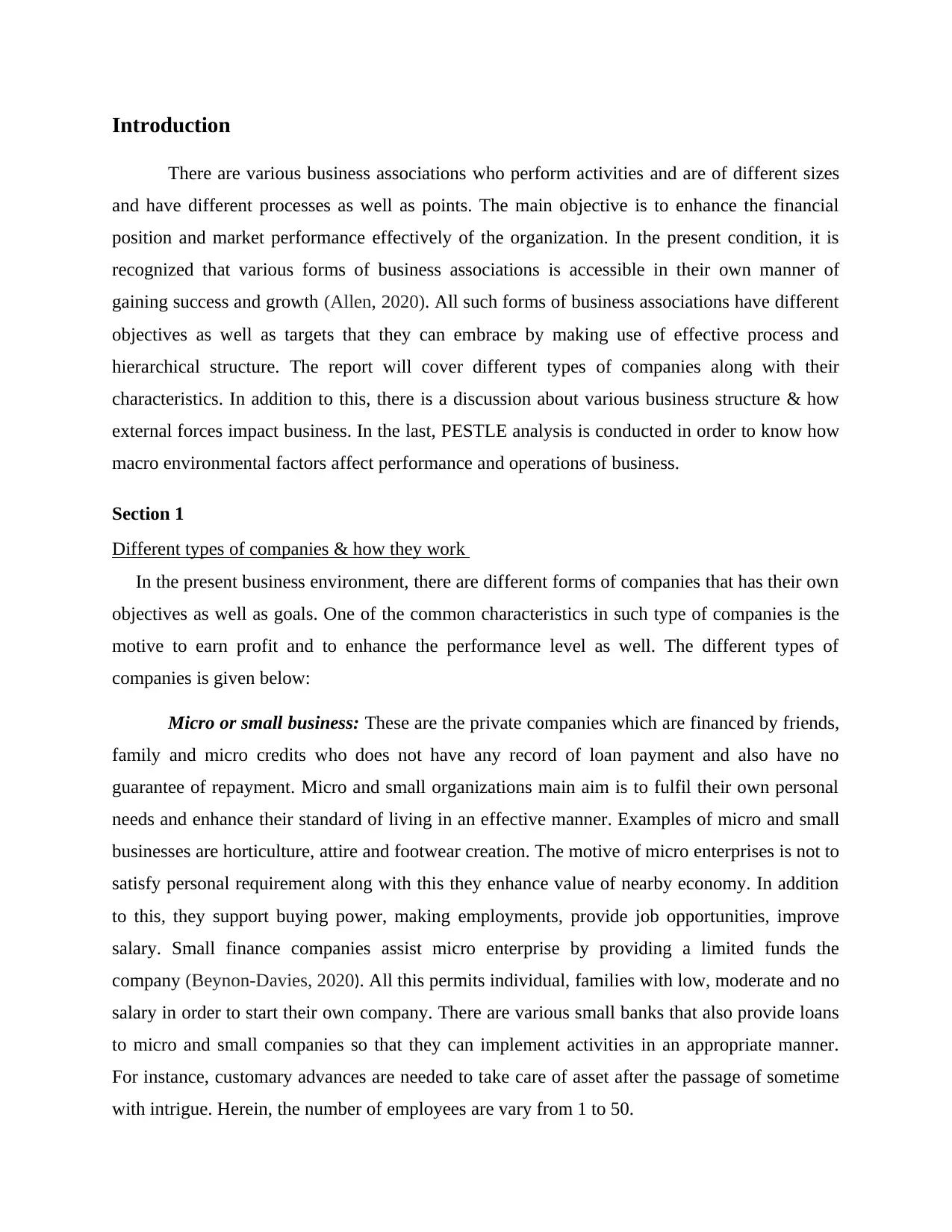
Introduction
There are various business associations who perform activities and are of different sizes
and have different processes as well as points. The main objective is to enhance the financial
position and market performance effectively of the organization. In the present condition, it is
recognized that various forms of business associations is accessible in their own manner of
gaining success and growth (Allen, 2020). All such forms of business associations have different
objectives as well as targets that they can embrace by making use of effective process and
hierarchical structure. The report will cover different types of companies along with their
characteristics. In addition to this, there is a discussion about various business structure & how
external forces impact business. In the last, PESTLE analysis is conducted in order to know how
macro environmental factors affect performance and operations of business.
Section 1
Different types of companies & how they work
In the present business environment, there are different forms of companies that has their own
objectives as well as goals. One of the common characteristics in such type of companies is the
motive to earn profit and to enhance the performance level as well. The different types of
companies is given below:
Micro or small business: These are the private companies which are financed by friends,
family and micro credits who does not have any record of loan payment and also have no
guarantee of repayment. Micro and small organizations main aim is to fulfil their own personal
needs and enhance their standard of living in an effective manner. Examples of micro and small
businesses are horticulture, attire and footwear creation. The motive of micro enterprises is not to
satisfy personal requirement along with this they enhance value of nearby economy. In addition
to this, they support buying power, making employments, provide job opportunities, improve
salary. Small finance companies assist micro enterprise by providing a limited funds the
company (Beynon-Davies, 2020). All this permits individual, families with low, moderate and no
salary in order to start their own company. There are various small banks that also provide loans
to micro and small companies so that they can implement activities in an appropriate manner.
For instance, customary advances are needed to take care of asset after the passage of sometime
with intrigue. Herein, the number of employees are vary from 1 to 50.
There are various business associations who perform activities and are of different sizes
and have different processes as well as points. The main objective is to enhance the financial
position and market performance effectively of the organization. In the present condition, it is
recognized that various forms of business associations is accessible in their own manner of
gaining success and growth (Allen, 2020). All such forms of business associations have different
objectives as well as targets that they can embrace by making use of effective process and
hierarchical structure. The report will cover different types of companies along with their
characteristics. In addition to this, there is a discussion about various business structure & how
external forces impact business. In the last, PESTLE analysis is conducted in order to know how
macro environmental factors affect performance and operations of business.
Section 1
Different types of companies & how they work
In the present business environment, there are different forms of companies that has their own
objectives as well as goals. One of the common characteristics in such type of companies is the
motive to earn profit and to enhance the performance level as well. The different types of
companies is given below:
Micro or small business: These are the private companies which are financed by friends,
family and micro credits who does not have any record of loan payment and also have no
guarantee of repayment. Micro and small organizations main aim is to fulfil their own personal
needs and enhance their standard of living in an effective manner. Examples of micro and small
businesses are horticulture, attire and footwear creation. The motive of micro enterprises is not to
satisfy personal requirement along with this they enhance value of nearby economy. In addition
to this, they support buying power, making employments, provide job opportunities, improve
salary. Small finance companies assist micro enterprise by providing a limited funds the
company (Beynon-Davies, 2020). All this permits individual, families with low, moderate and no
salary in order to start their own company. There are various small banks that also provide loans
to micro and small companies so that they can implement activities in an appropriate manner.
For instance, customary advances are needed to take care of asset after the passage of sometime
with intrigue. Herein, the number of employees are vary from 1 to 50.
Paraphrase This Document
Need a fresh take? Get an instant paraphrase of this document with our AI Paraphraser

Medium size business: These are those form of company that have asset more than small
organization and have employees between 50 to 250. It is analyzed that income of medium size
business is around £36m. There are high number of medium size business in an economy that
contributes directly towards the growth as well as development of economy. One of the main
motive of such businesses is to earn high profits and expand their business operations in an
appropriate manner. Captify, Ella’s Kitchen are such an example of medium size business that is
operated in UK.
Large size business: This types of companies have wide scope and have colossal capital &
high number of employees so that they can perform and implement activities at global level. In
addition to this, they have more than 250 employees and main aim is to satisfy customers in
order to enhance its brand image and strengthen market position effectively (Fazzini, 2018). It is
determine such size of companies has turnover more than 1.5 billion euros and absolute
accounting report measure exceeds of 2 billion euros. The example of large size companies are
TESCO, General Motors and many more.
Section 2
Different companies operate at the environment
Apart from the small, medium and large size business, there are also other form of
business that is accessible within the commercial center. It is determined that such organization
have their own way of working and procedure to implement activities. The companies are given
below:
Sole trader business: It is an unincorporated business entity which is owned by a single
person or an individual. In addition to this, it is simple form of business that require less amount
of finance as well as legal protection for business owner. There is also have tax benefits as
income earned is consider as owner’s personal income that is taxed once.
Partnership: It is a form of business that is owned by two or more individual who is
known as partners, In addition to this, such partners share profit and loss equally or as per the
partnership deed. Partnership form of business is also have an advantage of taxation that is there
income is treated as owner’s income which is taxed once. There are different forms of
organization and have employees between 50 to 250. It is analyzed that income of medium size
business is around £36m. There are high number of medium size business in an economy that
contributes directly towards the growth as well as development of economy. One of the main
motive of such businesses is to earn high profits and expand their business operations in an
appropriate manner. Captify, Ella’s Kitchen are such an example of medium size business that is
operated in UK.
Large size business: This types of companies have wide scope and have colossal capital &
high number of employees so that they can perform and implement activities at global level. In
addition to this, they have more than 250 employees and main aim is to satisfy customers in
order to enhance its brand image and strengthen market position effectively (Fazzini, 2018). It is
determine such size of companies has turnover more than 1.5 billion euros and absolute
accounting report measure exceeds of 2 billion euros. The example of large size companies are
TESCO, General Motors and many more.
Section 2
Different companies operate at the environment
Apart from the small, medium and large size business, there are also other form of
business that is accessible within the commercial center. It is determined that such organization
have their own way of working and procedure to implement activities. The companies are given
below:
Sole trader business: It is an unincorporated business entity which is owned by a single
person or an individual. In addition to this, it is simple form of business that require less amount
of finance as well as legal protection for business owner. There is also have tax benefits as
income earned is consider as owner’s personal income that is taxed once.
Partnership: It is a form of business that is owned by two or more individual who is
known as partners, In addition to this, such partners share profit and loss equally or as per the
partnership deed. Partnership form of business is also have an advantage of taxation that is there
income is treated as owner’s income which is taxed once. There are different forms of
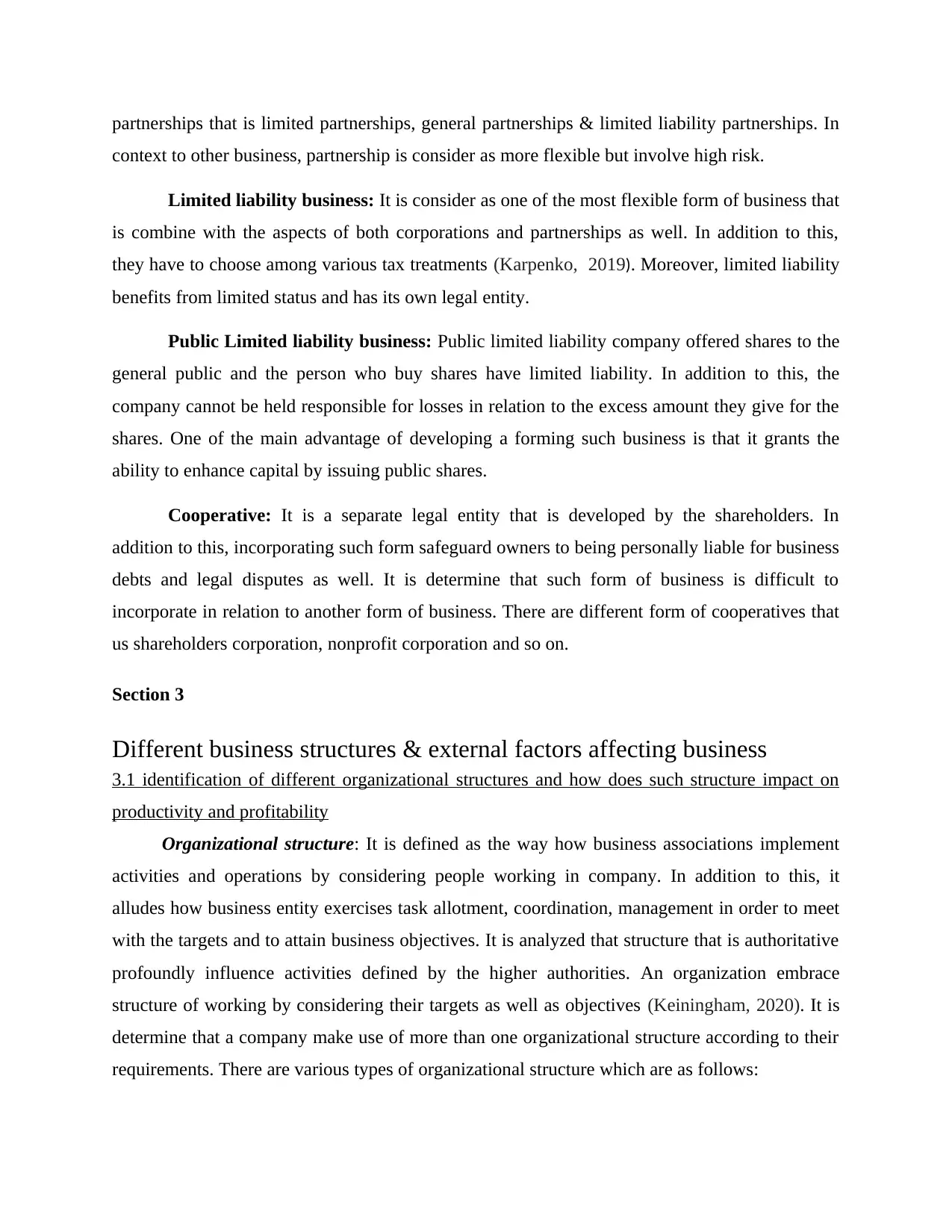
partnerships that is limited partnerships, general partnerships & limited liability partnerships. In
context to other business, partnership is consider as more flexible but involve high risk.
Limited liability business: It is consider as one of the most flexible form of business that
is combine with the aspects of both corporations and partnerships as well. In addition to this,
they have to choose among various tax treatments (Karpenko, 2019). Moreover, limited liability
benefits from limited status and has its own legal entity.
Public Limited liability business: Public limited liability company offered shares to the
general public and the person who buy shares have limited liability. In addition to this, the
company cannot be held responsible for losses in relation to the excess amount they give for the
shares. One of the main advantage of developing a forming such business is that it grants the
ability to enhance capital by issuing public shares.
Cooperative: It is a separate legal entity that is developed by the shareholders. In
addition to this, incorporating such form safeguard owners to being personally liable for business
debts and legal disputes as well. It is determine that such form of business is difficult to
incorporate in relation to another form of business. There are different form of cooperatives that
us shareholders corporation, nonprofit corporation and so on.
Section 3
Different business structures & external factors affecting business
3.1 identification of different organizational structures and how does such structure impact on
productivity and profitability
Organizational structure: It is defined as the way how business associations implement
activities and operations by considering people working in company. In addition to this, it
alludes how business entity exercises task allotment, coordination, management in order to meet
with the targets and to attain business objectives. It is analyzed that structure that is authoritative
profoundly influence activities defined by the higher authorities. An organization embrace
structure of working by considering their targets as well as objectives (Keiningham, 2020). It is
determine that a company make use of more than one organizational structure according to their
requirements. There are various types of organizational structure which are as follows:
context to other business, partnership is consider as more flexible but involve high risk.
Limited liability business: It is consider as one of the most flexible form of business that
is combine with the aspects of both corporations and partnerships as well. In addition to this,
they have to choose among various tax treatments (Karpenko, 2019). Moreover, limited liability
benefits from limited status and has its own legal entity.
Public Limited liability business: Public limited liability company offered shares to the
general public and the person who buy shares have limited liability. In addition to this, the
company cannot be held responsible for losses in relation to the excess amount they give for the
shares. One of the main advantage of developing a forming such business is that it grants the
ability to enhance capital by issuing public shares.
Cooperative: It is a separate legal entity that is developed by the shareholders. In
addition to this, incorporating such form safeguard owners to being personally liable for business
debts and legal disputes as well. It is determine that such form of business is difficult to
incorporate in relation to another form of business. There are different form of cooperatives that
us shareholders corporation, nonprofit corporation and so on.
Section 3
Different business structures & external factors affecting business
3.1 identification of different organizational structures and how does such structure impact on
productivity and profitability
Organizational structure: It is defined as the way how business associations implement
activities and operations by considering people working in company. In addition to this, it
alludes how business entity exercises task allotment, coordination, management in order to meet
with the targets and to attain business objectives. It is analyzed that structure that is authoritative
profoundly influence activities defined by the higher authorities. An organization embrace
structure of working by considering their targets as well as objectives (Keiningham, 2020). It is
determine that a company make use of more than one organizational structure according to their
requirements. There are various types of organizational structure which are as follows:
⊘ This is a preview!⊘
Do you want full access?
Subscribe today to unlock all pages.

Trusted by 1+ million students worldwide

Functional organization structure: In this types of organizational structure, departments
are divided as per their level of capacity and each have their own representative and director as
per their job. In addition to this, herein the task is assigned to employees according to their skills,
knowledge and competencies so that activities is implemented in an effective manner which in
turn has positive impact on performance as well as profitability of a company. The task is
assigned by higher authorities and have control on activities. In addition to this, herein
employees work with full potential as the work assigned to them is according to their interest
which help business entity to attain objectives within stipulated time period.
Divisional organization structures: It is a firm of structure which groups each organizational
function into a division and each function involves required resources & support as well. For
example, marketing department, finance department, IT department and many more. In addition
to this using of such organizational structure assist a company to assign responsibilities easily
that leads to attainment of positive results.
3.2 How various external factors effect on performance of a business – PESTLE Analysis
PESTLE analysis is defined as a framework that is used by companies in order to analyze
the impact of business environment factors on performance and operations of a company (Netz,
Svensson and Brundin, 2020). In addition to this, it also help in developing effective strategies in
order to deal with such complex environment. It mainly involve six major external factors that on
productivity of a company. It is important for an organization to conduct external analysis with
the help of PESTLE framework so that they can gain knowledge about the threats and
shortcomings of business. The different elements of PESTLE analysis is discussed below:
Political factors: It is defined as the level to which government interference within the
operations as well as activities of a company. It involve components such as exchange
rate, political stability and instability, exchange rates and so on. In addition to this, it is
analyzed that political factors alludes evert component with relation to laws intercession
within the business. Analysis of all this components help company to gain insight about
how government impact on their performance and gainfulness. It is significant for an
organization to consider all the political factors before taking any decision such as
expanding business operations, advertising and many more.
are divided as per their level of capacity and each have their own representative and director as
per their job. In addition to this, herein the task is assigned to employees according to their skills,
knowledge and competencies so that activities is implemented in an effective manner which in
turn has positive impact on performance as well as profitability of a company. The task is
assigned by higher authorities and have control on activities. In addition to this, herein
employees work with full potential as the work assigned to them is according to their interest
which help business entity to attain objectives within stipulated time period.
Divisional organization structures: It is a firm of structure which groups each organizational
function into a division and each function involves required resources & support as well. For
example, marketing department, finance department, IT department and many more. In addition
to this using of such organizational structure assist a company to assign responsibilities easily
that leads to attainment of positive results.
3.2 How various external factors effect on performance of a business – PESTLE Analysis
PESTLE analysis is defined as a framework that is used by companies in order to analyze
the impact of business environment factors on performance and operations of a company (Netz,
Svensson and Brundin, 2020). In addition to this, it also help in developing effective strategies in
order to deal with such complex environment. It mainly involve six major external factors that on
productivity of a company. It is important for an organization to conduct external analysis with
the help of PESTLE framework so that they can gain knowledge about the threats and
shortcomings of business. The different elements of PESTLE analysis is discussed below:
Political factors: It is defined as the level to which government interference within the
operations as well as activities of a company. It involve components such as exchange
rate, political stability and instability, exchange rates and so on. In addition to this, it is
analyzed that political factors alludes evert component with relation to laws intercession
within the business. Analysis of all this components help company to gain insight about
how government impact on their performance and gainfulness. It is significant for an
organization to consider all the political factors before taking any decision such as
expanding business operations, advertising and many more.
Paraphrase This Document
Need a fresh take? Get an instant paraphrase of this document with our AI Paraphraser

Economic factors: This factor plays an important role and straightforwardly impact on
activities as well as gainfulness of a business entity. It consist of factors like trade rates,
loan cost, financial development and so on. It is significant for company to analyze all
such factors so that an organization gain income benefits.
Social factors: It is significant for an organization to consider all the social factors before
offering products as well as service at marketplace. In addition to this, it involve factors
such as values, beliefs, norms, culture and opinions of an individual (Ovadia, 2018). It is
essential for a company to consider age appropriation, well being, perspective of market
in which they are offering so that requirements of customer is fulfilled that has positive
influence of brand image and revenue level of a business entity.
Technological factors: Technology plays a significant role as it impact on the overall
choice of customers and towards brand as well. Nowadays, customers prefer to buy those
products as well as service which is innovative and unique in market. So it is important
for accompany to bring innovation at marketplace in order to sustain and retain customers
for longer time period. Moreover, most of the companies focuses on bringing some
innovative solution for customer and to reach large number of leads which leads to
increase in sales and profitability of an organization.
Legal factors: It alludes to various laws and acts such as consumer laws, buyer rights,
health and safety, security law that is developed by government and followed by
companies in order to implement activities smoothly and deny penalties as well. It is
important for company to focus on such laws in order to ensure legitimate procedure &
administrative mediation that cause misfortunes of company.
Environmental factors: It is the central point that have impacting benefits and efficiency
of a company. It is significant for a business entity to make sure that they are not causing
any shortage of asset on earth. Moreover, it is also important to ensure that they do not
discharge any of contaminations within the conditions. Most of the companies focuses on
declining the use of carbon foot points in order to protect environment (Pranjal and
Sarkar, 2020). This also help company to improve its brand image that impact on market
performance in an effective manner.
activities as well as gainfulness of a business entity. It consist of factors like trade rates,
loan cost, financial development and so on. It is significant for company to analyze all
such factors so that an organization gain income benefits.
Social factors: It is significant for an organization to consider all the social factors before
offering products as well as service at marketplace. In addition to this, it involve factors
such as values, beliefs, norms, culture and opinions of an individual (Ovadia, 2018). It is
essential for a company to consider age appropriation, well being, perspective of market
in which they are offering so that requirements of customer is fulfilled that has positive
influence of brand image and revenue level of a business entity.
Technological factors: Technology plays a significant role as it impact on the overall
choice of customers and towards brand as well. Nowadays, customers prefer to buy those
products as well as service which is innovative and unique in market. So it is important
for accompany to bring innovation at marketplace in order to sustain and retain customers
for longer time period. Moreover, most of the companies focuses on bringing some
innovative solution for customer and to reach large number of leads which leads to
increase in sales and profitability of an organization.
Legal factors: It alludes to various laws and acts such as consumer laws, buyer rights,
health and safety, security law that is developed by government and followed by
companies in order to implement activities smoothly and deny penalties as well. It is
important for company to focus on such laws in order to ensure legitimate procedure &
administrative mediation that cause misfortunes of company.
Environmental factors: It is the central point that have impacting benefits and efficiency
of a company. It is significant for a business entity to make sure that they are not causing
any shortage of asset on earth. Moreover, it is also important to ensure that they do not
discharge any of contaminations within the conditions. Most of the companies focuses on
declining the use of carbon foot points in order to protect environment (Pranjal and
Sarkar, 2020). This also help company to improve its brand image that impact on market
performance in an effective manner.
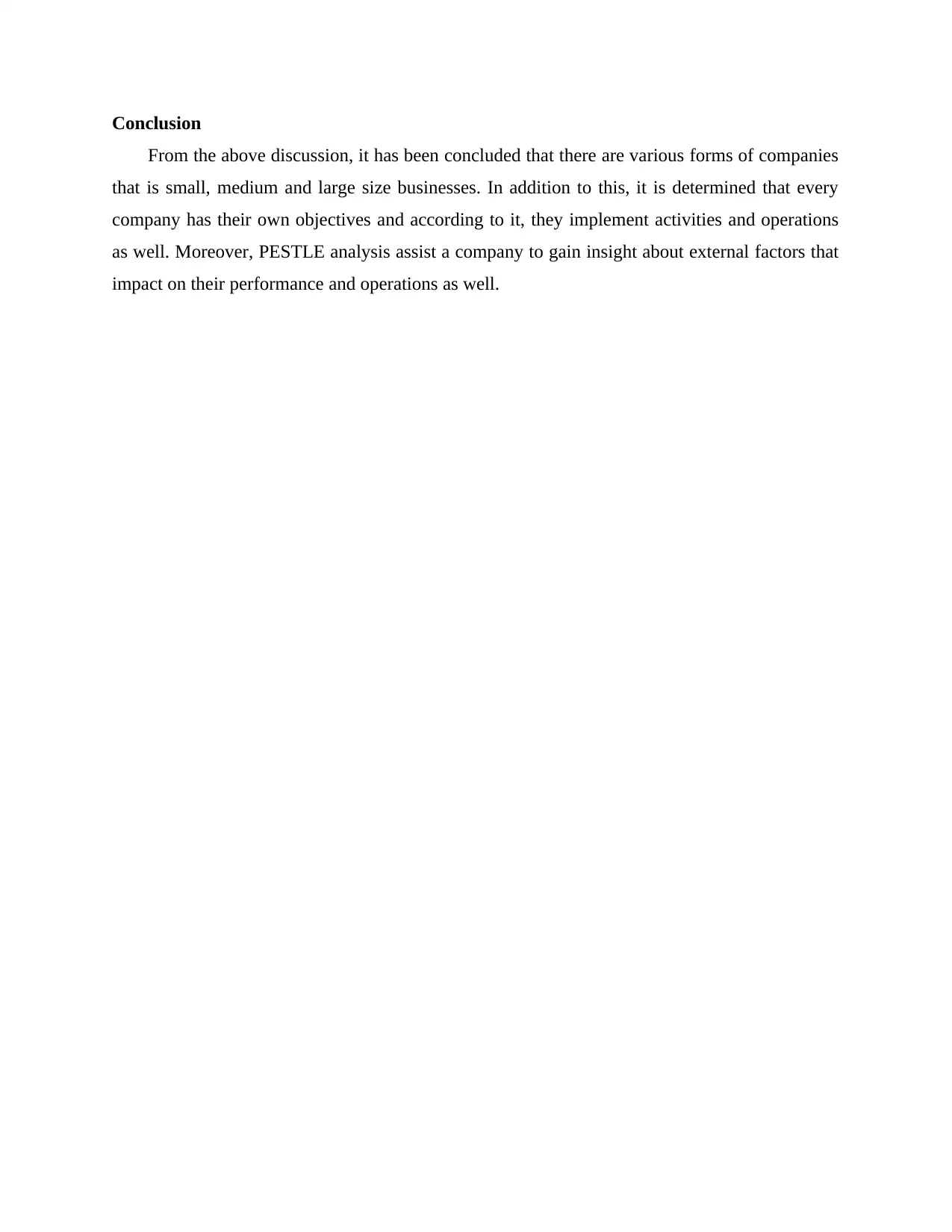
Conclusion
From the above discussion, it has been concluded that there are various forms of companies
that is small, medium and large size businesses. In addition to this, it is determined that every
company has their own objectives and according to it, they implement activities and operations
as well. Moreover, PESTLE analysis assist a company to gain insight about external factors that
impact on their performance and operations as well.
From the above discussion, it has been concluded that there are various forms of companies
that is small, medium and large size businesses. In addition to this, it is determined that every
company has their own objectives and according to it, they implement activities and operations
as well. Moreover, PESTLE analysis assist a company to gain insight about external factors that
impact on their performance and operations as well.
⊘ This is a preview!⊘
Do you want full access?
Subscribe today to unlock all pages.

Trusted by 1+ million students worldwide
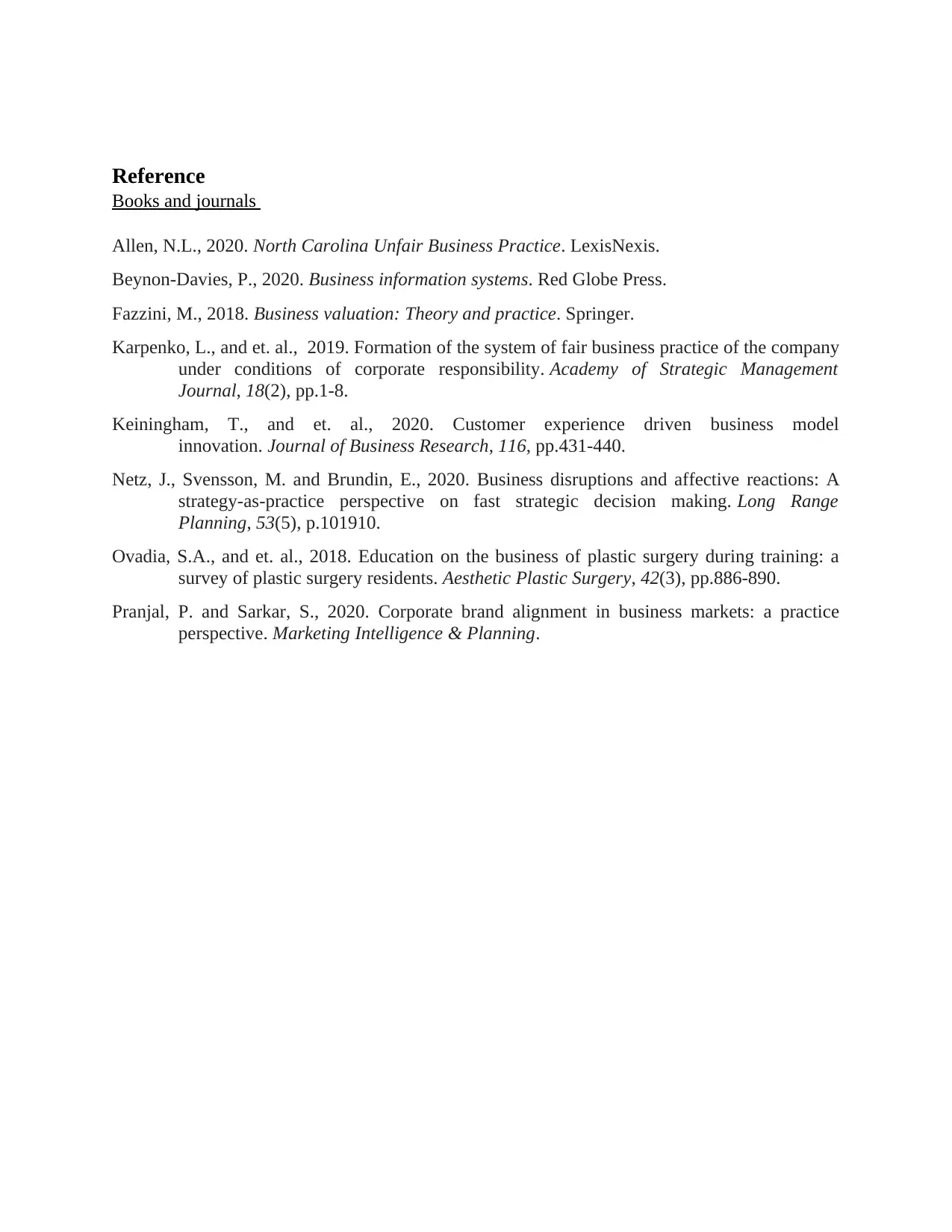
Reference
Books and journals
Allen, N.L., 2020. North Carolina Unfair Business Practice. LexisNexis.
Beynon-Davies, P., 2020. Business information systems. Red Globe Press.
Fazzini, M., 2018. Business valuation: Theory and practice. Springer.
Karpenko, L., and et. al., 2019. Formation of the system of fair business practice of the company
under conditions of corporate responsibility. Academy of Strategic Management
Journal, 18(2), pp.1-8.
Keiningham, T., and et. al., 2020. Customer experience driven business model
innovation. Journal of Business Research, 116, pp.431-440.
Netz, J., Svensson, M. and Brundin, E., 2020. Business disruptions and affective reactions: A
strategy-as-practice perspective on fast strategic decision making. Long Range
Planning, 53(5), p.101910.
Ovadia, S.A., and et. al., 2018. Education on the business of plastic surgery during training: a
survey of plastic surgery residents. Aesthetic Plastic Surgery, 42(3), pp.886-890.
Pranjal, P. and Sarkar, S., 2020. Corporate brand alignment in business markets: a practice
perspective. Marketing Intelligence & Planning.
Books and journals
Allen, N.L., 2020. North Carolina Unfair Business Practice. LexisNexis.
Beynon-Davies, P., 2020. Business information systems. Red Globe Press.
Fazzini, M., 2018. Business valuation: Theory and practice. Springer.
Karpenko, L., and et. al., 2019. Formation of the system of fair business practice of the company
under conditions of corporate responsibility. Academy of Strategic Management
Journal, 18(2), pp.1-8.
Keiningham, T., and et. al., 2020. Customer experience driven business model
innovation. Journal of Business Research, 116, pp.431-440.
Netz, J., Svensson, M. and Brundin, E., 2020. Business disruptions and affective reactions: A
strategy-as-practice perspective on fast strategic decision making. Long Range
Planning, 53(5), p.101910.
Ovadia, S.A., and et. al., 2018. Education on the business of plastic surgery during training: a
survey of plastic surgery residents. Aesthetic Plastic Surgery, 42(3), pp.886-890.
Pranjal, P. and Sarkar, S., 2020. Corporate brand alignment in business markets: a practice
perspective. Marketing Intelligence & Planning.
1 out of 10
Related Documents
Your All-in-One AI-Powered Toolkit for Academic Success.
+13062052269
info@desklib.com
Available 24*7 on WhatsApp / Email
![[object Object]](/_next/static/media/star-bottom.7253800d.svg)
Unlock your academic potential
Copyright © 2020–2025 A2Z Services. All Rights Reserved. Developed and managed by ZUCOL.





